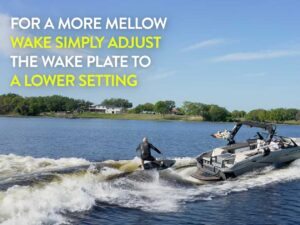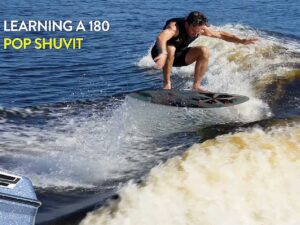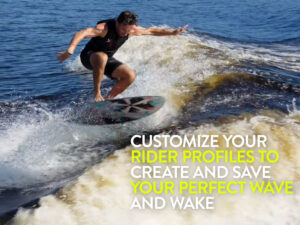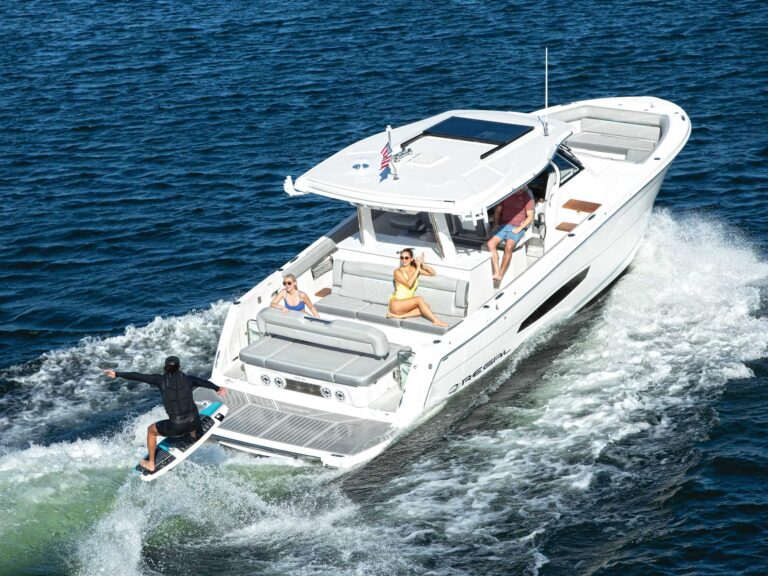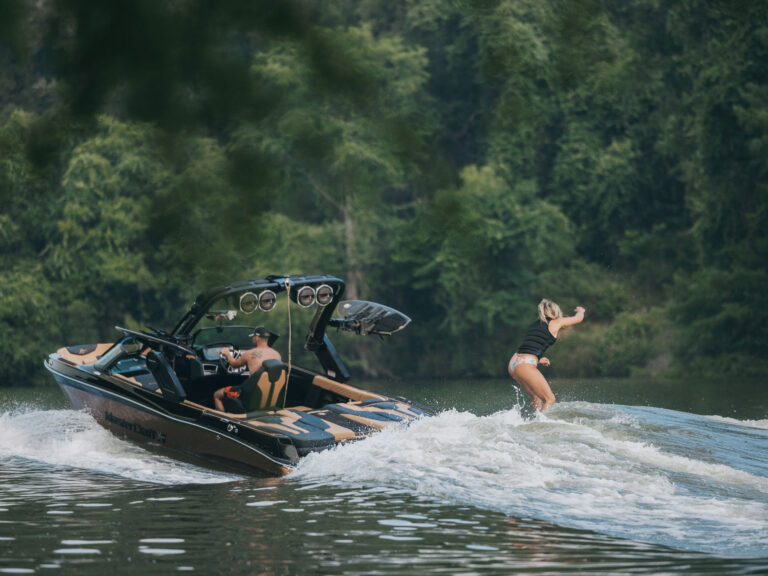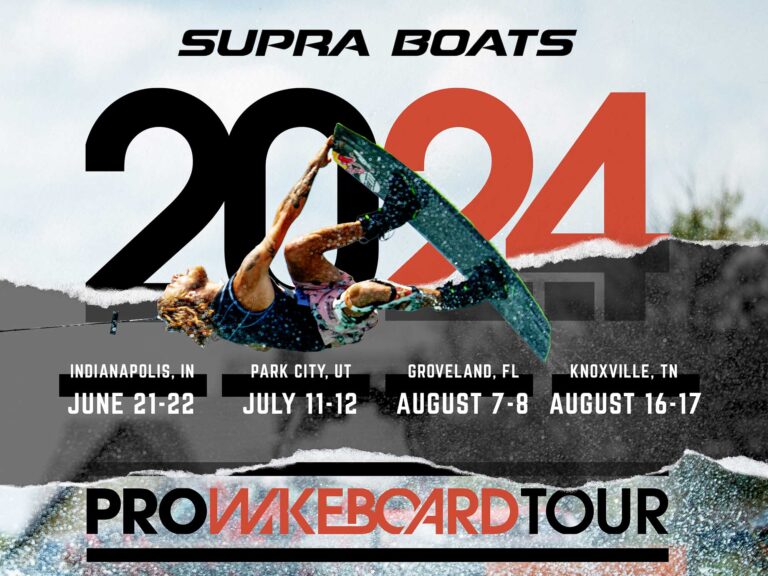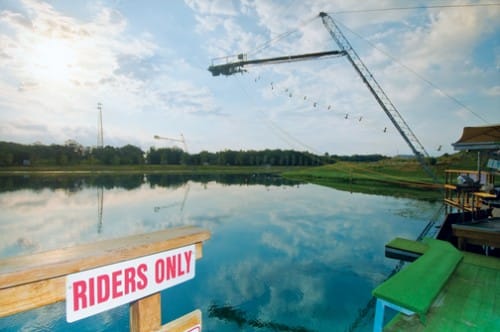
Jimmy LaRiche used to suck at wakeboarding. Really, he was no good. In fact, after he flopped in one of his first contests, Jimmy LaRiche’s dad tried to gently steer him away from the sport, saying, “You know, wakeboarding isn’t for everybody.” Yet today, a mere five years after crashing and burning in that event, LaRiche is one of the best professional wakeboarders in the world. He’s one of only six riders to land a documented 1080. After dominating the Junior Men’s division of the Pro Wakeboard Tour last year, he finished behind only Rusty Malinoski at the 2009 Air Nautique Wake Games, his official debut in the pro division. So, how did LaRiche go from chump to champ so quickly? Much must be chalked up to natural talent and LaRiche’s dedication, of course, but a healthy part of the credit for his meteoric rise is due to Ski Rixen, the South Florida cable park where LaRiche spent years and countless laps honing his riding.
“I feel like I owe most of my career to Ski Rixen,” LaRiche says. “Aside from Dean Lavelle’s school, the only place to ride in South Florida was the cable. I don’t know for sure, but I probably did a million laps at Rixen over the years.”
LaRiche’s story isn’t unique. In fact, Adam Errington, who finished just behind LaRiche at Wake Games, followed a virtually identical path to wakeboarding success. Errington had never even been on a wakeboard before his first trip to the Orlando Watersports Complex at age 13. Dozens more now-professional riders have used the unmatched water time of places like OWC and Texas Ski Ranch to propel themselves into the elite ranks of wakeboarding and wakeskating.
With three new cable wakeboarding parks opening in the country in a little more than a year and dozens more on the horizon, the route LaRiche, Errington and others followed to the top of professional wakeboarding is opening to thousands of riders.
Park Proliferation
Last year, two Florida parks — Revolution in Fort Myers and McCormicks near Tampa — became the sixth and seventh full-size cable parks in the country, joining Ski Rixen; OWC; TSR; KC Watersports in Hillsdale, Kansas; and Mid America Wakesports in Guthrie, Oklahoma. On June 2, Wake Nation celebrated its grand opening just outside Cincinnati, bringing the grand total of full-size U.S. cable parks to eight. The ninth, WakeSport Ranch, will open in Cresson, Texas, near Dallas, before the end of the year.
Nine parks spread out across a country as big as the United States may not seem all that impressive, especially when you consider Germany — a country roughly the size of Montana — has somewhere around 60 (no one is quite sure of the exact count). But we’re just getting started. The States had only two cable wakeboarding parks —Ski Rixen and OWC — in 1999, and nine parks by 2009 represents a pace of nearly a park a year. Even in the current recession, that pace is quickening.
Matt Hickman of The Wake Park Project and Blake Hess of Cable Wake Parks, the two distributors of turnkey cable operations in the United States, both expect at least three new parks to open in 2010. At this rate, it’s realistic to imagine close to 50 parks spread across the country 10 years from now.
“We have multiple serious leads in every state in this country,” Hickman says. “This is a trend that’s working its way from east to west. It started in Florida, then it went to Texas and the Midwest. People on the West Coast are going to have access to cables too. It’s really just a matter of time.”
Park Populating
Earlier this summer, Rodney Dorman, a 57-year-old Texan who owns a steel plumbing and electrical contracting business just outside Fort Worth, took his 14-year-old son, Blake, to Texas MasterCraft to ride the boat dealer’s new Sesitec System 2.0 cable park. Although Blake had never been on a wakeboard before, Texas MasterCraft coach Brian Sasser had him up and riding after two attempts. Blake was so taken with wakeboarding that Dorman decided to buy a boat, a used ProStar 209. A week later, Dorman returned to Texas MasterCraft and upgraded to a brand-new X-Star. Now, even Dorman is riding.
“It’s like an obsession once you start with it,” Dorman says. “It’s all about wakeboarding now — it took my family over.”
One of the most promising results of the recent surge in cable wakeboarding parks is that more parks equals more riders. Parks diminish the barriers into the sport, offering cheaper and easier access to wakeboarding than ever before. Thanks to cable parks, wakeboarders no longer need to own a boat or know somebody who owns a boat in order to ride. The cost of cable — the average price is about $37 per day and $20 per hour — is affordable for the majority of Americans. For more than a decade, kids like LaRiche and Errington have fallen in love with wakeboarding at Ski Rixen and OWC. Each new park has the potential to generate hundreds of new riders just like them.
“I’ve had days when I worked down on the cable and at the end of the day, I thought, ‘Man, I just taught 30 people how to wakeboard today.'” says Hess, a longtime employee at TSR. “That’s obviously a huge day, but it happens all the time. It’s amazing how many people have learned to ride or gotten into the sport because of each cable that’s out there.”
More riders also means greater demand for boards, boots, life jackets and, eventually, wakeboard boats too. As the Dormans proved, the story of the first-time wakeboarder turned die-hard rider and boat owner is no fantasy.
“Cables make wakeboarding accessible to so many more people who may not have the opportunity to try it otherwise,” Andrew Adkison says. “The more cable riders we have, the more boat riders we have and vice versa.”
Park Life
When Errington was a kid on summer vacation, his mom would drop him off at OWC every morning. He’d buy an all-day pass and spend all morning and afternoon riding with his friends before she returned to pick him up in the evening. LaRiche did the same thing at Ski Rixen, getting in line behind friends who were better than him and mimicking their path through the park.
“The cable park was such an awesome thing for a kid like me,” LaRiche says. “You go to the cable every day and ride with a group of friends, and it didn’t matter who was better or who learned what. It was all about fun — people helping each other and taking laps, following behind your best friend — that was the best thing ever.”
Much like parks in cable-crazy Germany, U.S. cables are emerging as social epicenters for wakeboarders. Essentially warm-weather ski resorts, cable wakeboarding parks attract a group of like-minded individuals in pursuit of a shared interest.
“One of the things I’ve noticed from riding at TSR is the community that cable parks create,” Tom Fooshee says. “Everybody shares the same passion, so you meet a lot of new people who push your riding. Then a lot of the guys who ride cable rip behind the boat too, so it helps you find people to ride in a boat with.”
Cable wakeboarding parks are far more than a lake, five towers and a mile worth of cable. On most weekends, TSR’s white-sand beach is dotted with bikini-clad college students from nearby Texas State University. CoCoNuts, a bar and grill with a patio that overlooks TSR’s cable and boat lakes, is just a short walk away. Parks are developing not only a community, but a lifestyle as well.
“The boating lifestyle is great,” says Shannon Starling, president of the World Wakeboarding Association. “That same aspect exists at the cable park. Cables are no longer a hole in the ground with a cable running around it. They have restaurants or concessions, a place to sit and relax and Internet access. You can go hang out all day.”
Park Progression
LaRiche no longer relies on Ski Rixen like he used to. He moved to Orlando a year ago. Today, if LaRiche wants to ride, he need only walk a couple dozen steps out his back door to the lake and his very own Super Air Nautique 230. Yet, cable parks sill play a huge role in his riding.
“I still go to the cable before I try new stuff off the wake,” LaRiche says. “I’m working on toeside 10s right now, and I finally got one off the kicker, which gives me more confidence to take it to the boat.”
In fact, dozens of pro wakeboarders use the cable to progress their riding behind the boat. Keith Lidberg learned more than half the moves he does behind the boat on the cable first, and he refers to Sesitec’s System 2.0 as the wakeboarder’s foam pit because of the system’s training-friendly configuration. Andrew Adkison says he tries tricks on the cable that he would never consider behind the boat. Errington says he does the same thing.
“I just recently learned how to do switch S-bends, and that was 100 percent due to the cable,” Errington says. “I don’t think I’d ever have tried it behind the boat if I hadn’t learned it on the cable first.”
Parks are ideal incubators of progression for a number of reasons. For starters, they offer unmatched time on the water. With up to nine riders on the water at the same time, cable wakeboarding parks let you ride more, which speeds up the learning curve.
“Water time is key if you want to become a better rider, and it’s not the easiest thing to do to get out behind the boat and pay for gas,” Errington says. “It’s much easier to spend $20 and get a pass to the cable. Whether it’s boat or cable, water time is what’s important, and it’s definitely easier to get it at the cable.”
Riding cable is also more forgiving. The upward pull of the cable makes air tricks easier and landings softer, removing some of the consequences associated with trying new moves behind the boat.
“One of the main reasons I ride cable now as a pro is the cable is a lot more forgiving than the boat,” Errington says. “The falls are easier, it’s a little but slower and it’s not as intimidating to try tricks. It definitely doesn’t hurt as much when you fall.”
Park Promotion
Groups like The Wake Park Project, Cable Wake Parks and the WWA are working to spread cable parks from coast to coast, but how can the average rider work to get a cable park in his area?
“The best thing he can do is stay involved with his local wakeboarding site,” Hickman says. “In Utah, there’s a group working to get a cable and they run a site, utahcableproject.blogspot.com, where they’re trying to gather support from the wake community. They have an e-mail list and alerts when they╒re going to have meetings. Dallaswakeboarding.com is another great example. They have updates all the time on the parks in progress in their area. Get involved in the forums and ask how you can help.”
Rail Wonderlands
Keith Lidberg’s rail prowess has always been associated with the years he spent as a coach at The Projects’ rail park, but he says he owes just as much credit to the Orlando Watersports Complex. Before he ever went to The Projects, Lidberg spent countless laps at OWC honing his presses.
Cable parks not only offer riders access to professionally built rails, they also allow riders to hit them with a frequency that’s unmatched by even the tight turns and maneuverability of a PWC. After all, you can hit the same rail at a cable park 100 times in an afternoon, boning out that back lip a little more each time.
“Cable is all about repetition,” Shaun Murray says. “That’s why so many cable riders are on with some big hammer tricks on rails and in the corners. You can session a rail for an hour, give another rail a go, then come back to the first rail an hour later.”
Park Light
If full-size cable parks are on the rise, their smaller, two-tower siblings are absolutely on fire. Ever since Sesitec debuted its System 2.0 at the first Red Bull Wake Lab event last September, The Wake Park Project has been using the straight-line system to build miniature cable parks all over the country.
The first System 2.0 park opened late last year at The Projects, where it quickly became a hot spot for Orlando pros. In April, Texas MasterCraft became the first boat dealership in the country to boast its own cable park. Over a two-week span in late May and early June, The Wake Park Project installed System 2.0s in a private backyard in Mansfield, Texas, and over a snow-making pond at Nordic Mountain, a ski resort in Wild Rose, Wisconsin.
Earlier this summer, Texas Ski Ranch unveiled a park pulled by Rixen’s two-tower cable system, the Little Bro, as a complement to it full-size cable.
System 2.0 and the Little Bro have proven multifaceted. System 2.0’s mobility — the towers can be disassembled, shipped and reassembled by just a few people — makes it perfect for exhibition. Events like Red Bull’s Wake Lab and Wake the Line are bringing cable, and wakeboarding in general, to audiences that otherwise might not have been exposed to it. In permanent parks, System 2.0 and Little Bro create both beginner-friendly learning environments and skate-style rail parks. For example, this summer Texas Ski Ranch is using its Little Bro park to teach beginners to get up and ride. But come fall, that same park will be dotted with rails and advanced-level wakeboarders and wakeskaters like Tom Fooshee and Aaron Reed.
System 2.0 and Little Bro are ideal for breaking in first-time riders because they lack the corners of full-size cables, which are often problematic for beginners. Plus, since they only support one rider at a time, an operator can stop and start the cable to pick up the rider whenever he falls. But beginners aren’t the only ones using straight-line cables to learn. Pros like Andrew Adkison and JD Webb use The Projects’ System 2.0 to test out tricks before taking them to the full-size cable, and super coach Mike Ferraro added System 2.0 to the training regimen of students like Nicola Butler and Raimi Merritt.
Words Luke Woodling Photos Bill Doster
